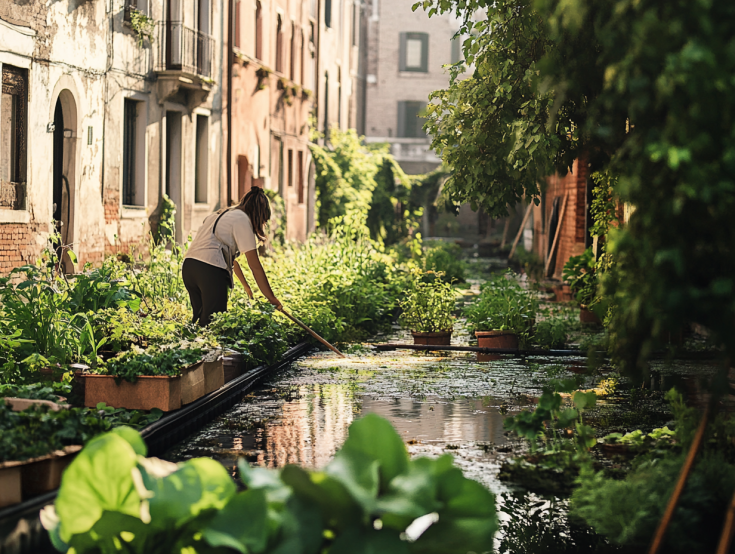Blue-green infrastructure for resilient cities III: Citizens’ participation: key learnings

On 29 October 2024, the Policy Learning Platform hosted the third episode of the webinar series 'Blue-green infrastructure for resilient cities'. This last session focused on citizen's participation.
This webinar inspired local and regional policy makers with practical examples on how citizen involvement plays a crucial role in boosting resilience, protecting biodiversity, and fostering social cohesion and innovation in green space management.. This episode explored inspiring solutions, good practices, guidance and recommendations backed by real-life examples from European cities and regions from many Interreg Europe projects.
Watch the recording, download the presentations and dive into the key learnings below.
Webinar recording
Webinar agenda
The webinar has been designed and moderated by Magda Michaliková and Astrid Severin, Thematic Experts for a Europe closer to citizens.
00:01:00 Introduction by Magda Michaliková and Astrid Severin, Thematic Experts for a Europe closer to citizen
00:09:30 Keynote speech by Thomas Schneider, City of Ingolstadt, Germany (Blue Green City), on involving citizens through hybrid participation formats.
00:26:02 Q&A: How many participants did you have, and how many time people had to answer the posters and to vote?
00:27:24 Q&A: Were all the citizens enthusiastic about the hybrid format you described? Were some reluctant about the online approach, for instance? And if so, how did you go on about this reluctance?
00:29:00 Q&A: Regarding blue infrastructure, do you have or how do you handle conflicts with nature? Do citizens complain about mosquitoes? What kind of measures do you use to control mosquitoes (biological selective agents or nerve-killing chemicals...)? Another topic is beavers, beavers are important ecosystem engineers, though can generate problems too. How do you handle beavers in the city? do you have possibility to swim in the river, Are your citizens interested in with direct contact with the Danube?
00:32:19 Q&A: How did you make citizens feel that their inputs was taken into account?
00:33:10 Q&A: Can you tell us about the most usable or interesting outcome?
00:38:49 Presentation by Ine Pertry, City of Roeselare, Belgium, on Small budget actions to mobilize citizens in climate adaptation. (InterRevita)
00:51:22 Q&A: A lot of trees to plant. Were are the going to be planted? Is there enough space? and what size is being planted?
00:52:42 Q&A: What regulations or requirements arising from legislation must residents consider when building a facade garden?
00:54:07 Q&A: Do you provide tools or machinery for people to remove the tiles? Is there any kind of insurance for them in case they get hurt or damage something in the Street? Do you have to develop any kind of agreement with the shops at Street level, when this actions are developing next to their walls?
00:55:25 Q&A: How do deal with the fear of damaging houses by plants?
00:57:27 Presentation by Andrea Porcelluzzi Municipality of Reggio Emilia, Italy, on Public participation for blue green infrastructure. (PROXIMITIES)
01:07:59 Q&A: Is the major maintenance, managed by CAI, financed (coverage of actual costs) by the Municipality?
01:08:45 Q&A: Did you make sure that all citizens groups can participate?
01:11:38 Presentation by Nika Kotoviča, , Riga City Council, Latvia, on Gardens of ‘Sports Palace’. (IMPETUS)
01:24:18: Q&A: How big are the garden boxes for every tenant?
01:24:58 Q&A: Is the area monitored in order to protect the garden plots?
01:26:05 Q&A: Were there other such places in Riga or was it a "one shot" initiative?
01:27:06 Q&A: What will happen after the 5 years when the private owner will request the land back? Can the municipality buy the land and leave it to the community?
01:28:43 Panel discussion
Key learnings
- Citizens’ participation is mainly about removing barriers - people are willing to be engaged and we need to make sure they can take part
- Make the issues visible/tangible and use as many channels as possible to reach everyone
- Citizens need to feel their input has been considered - keep them informed on the output and how their feedback is used
- People want to get involved in making their neighbourhoods greener and more pleasant – support them
- Make sure to involve people who are not usually involved (poor, disabilities)
- Use abandoned places and brownfields for temporary use – for example for creating urban gardens
- Define very specific targets for green infrastructure – tree planting, de-sealing, façade gardens, flower beds
- Have a hybrid approach to public participation – online and on-site
- Involve citizens through workshops, neighbourhood labs, communication campaigns, online surveys, labs with youth and schools
- Support citizens in installing green facades on private buildings, planting trees and flower beds in their neighbourhood
Presentations
Download the presentations below.

